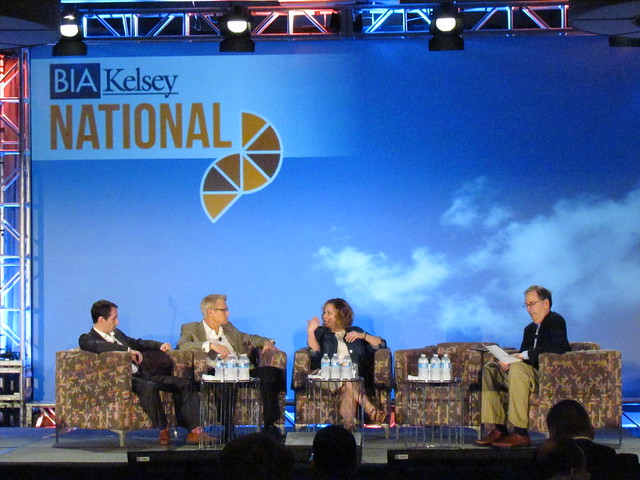
To kick-off BIA/Kelsey NATIONAL, the analyst team sits down to review 2015 – 2019 local advertising across 12 different channels and 94 industries, summarizing key issues for marketers over the next half decade.
Michael Boland, Chief Analyst and Vice President of Content, BIA/Kelsey
Peter Krasilovsky, Vice President, BIA/Kelsey
Steve Marshall, Research Director, BIA/Kelsey
Stacey Sedbrook, Vice President of Strategic Sales Consulting
Steve Marshall opens with our Local Commerce Monitor results on franchisees. They send $87K-plus, the highest level of marketing spend among the SMBs BIA/Kelsey tracks. They are highly engaged in digital — 42.9 percent of 2015 spending will be on digital; again, far ahead of the average SMB.
Franchises also spend at least 10 hours a week on social networks. About 85 percent maintain customer lists (compared to only about half of SMBs have customer lists in digital form). Seventy-one percent of franchises will have a loyalty program this year. This is a vindication of loyalty programs. Hand in hand with these loyalty programs, franchises are driving huge investments in discounting — 50.7 percent of revenue will be due to discount sales tied to loyalty programs.
This is the wave — loyalty and discounting — that will sweep the local space. There will be a much deeper, more committed relationship between the franchises and customers.
Franchises tend to favor buying through on-premise sales reps (feet on the street), even though many have national agency relationships. The franchises buy most through agencies and are extremely satisfied. Sixty-three percent are extremely satisfied with their agency relationships, though they prefer making individual purchases with assistance (expertise) from the agency. “They like a partner for these activities versus doing it themselves.”
Co-op advertising represents about $50 billion in U.S. spend annually and franchisees are the most prevalent users of co-op (more than 50 percent of all co-op monies flow through franchises). As a result, they want more analytics and analysis for their planning and assessment of campaigns.
Next up, Mike Boland discusses technology, particularly mobile.

Mobile ad revenues will grow from $13.25 billion in 2014 to $41.63 percent in 2019. In mobile, brands are the majority early adopters. YP, Yelp and other directories participate, but more than half is brand spending.
There are many flavors of ad targeting in mobile. It is no longer a matter of simply being geo-targeted, but must include contextually relevant information on the mobile devices. Using local area codes perform better than 800# listings, because they are perceived as actually local.
Bringing local inventory to bear on these opportunities, bringing POS inventory online as Google is doing, will be critical to market growth.
The static display ad is dying as live targeting takes on the role of providing context to mobile users.
Location-based programmatic ads are making headway. Weather, for example, can be used to address a customer with a topical offer. For example, a gym can send a coupon to a runner when it is raining: “Come in and run out of the rain.” These ads are starting to perform well.
Competitive conquesting works in retail, but struggles in restaurants. “There are so many different shades to these new opportunities, and it requires a lot of testing,” Boland said. Think of location as an audience profiling tool — where are consumers going and what does it say about the consumer that brands can use to create resonant messaging for consumers.
Contextual location targeting, such as a consumer at Wrigley Field, is a rich starting point for engagement. Drawing in other activities around that location and demographics.
“Everything I just mentioned can only happen when the location is accurate,” Boland concluded. “But the dirty little secret is that many location tags are wrong.” That’s a critical area for the market development and we have a session about this later this week.
Now Stacey Sedbrook: Are companies really learning use national and local brand targeting. Brand is centric, the location is subservient to the brand. And it is all over the board (for the same reasons that Gregg Stewart identified earlier). Talent development is going to be essential.
Stacey suggests it is important to “super-serve” the brand behind franchises, so we still need to be near the national brands, such as locating near Detroit for auto. The relationships matter more, and sales will continue to thrive.
Programmatic ads do not replace the human relationships that media companies have built with brands. Steve Marshall adds that he sees a tremendous need for integrators who do consultative selling with brands. Stacey: Make the local franchise group happy. So, send out a “hunter” to bring in brand deals, but hand fulfillment and account management to the local staff. Relationships matter.
Programmatic feels like “a buying method” to talk about targeting demographic, location with the “humble display ad.” Mike Boland: “This is bringing the tenants of search to the local display ads.”
That’s the session.

This Post Has 0 Comments